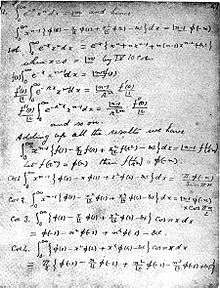Ramanujan's master theorem
In mathematics, Ramanujan's master theorem (named after mathematician Srinivasa Ramanujan[1]) is a technique that provides an analytic expression for the Mellin transform of an analytic function.

The result is stated as follows:
If a complex-valued function has an expansion of the form
then the Mellin transform of is given by
where is the gamma function.
It was widely used by Ramanujan to calculate definite integrals and infinite series.
Higher-dimensional versions of this theorem also appear in quantum physics (through Feynman diagrams).[2]
A similar result was also obtained by J. W. L. Glaisher.[3]
Alternative formalism
An alternative formulation of Ramanujan's master theorem is as follows:
which gets converted to the above form after substituting and using the functional equation for the gamma function.
The integral above is convergent for .
Proof
The proof of Ramanujan's Master Theorem provided by G. H. Hardy[4] employs the Cauchy's residue theorem and the well-known Mellin inversion theorem.
Application to Bernoulli polynomials
The generating function of the Bernoulli polynomials is given by:
These polynomials are given in terms of Hurwitz zeta function:
by for . By means of Ramanujan master theorem and generating function of Bernoulli polynomials one will have following integral representation:[5]
valid for .
Application to the Gamma function
Weierstrass's definition of the Gamma function
is equivalent to expression
where is the Riemann zeta function.
Then applying Ramanujan master theorem we have:
valid for .
Special cases of and are
Mathematica 7 is unable to compute these examples.[6]
References
- ↑ B. Berndt. Ramanujan’s Notebooks, Part I. Springer-Verlag, New York, 1985.
- ↑ A generalized Ramanujan Master Theorem applied to the evaluation of Feynman diagrams by Iv´an Gonz´alez, V. H. Moll and Iv´an Schmidt
- ↑ J. W. L. Glaisher. A new formula in definite integrals. The London, Edinburgh, and Dublin Philosophical Magazine and Journal of Science, 48(315):53–55, Jul 1874.
- ↑ G. H. Hardy. Ramanujan. Twelve Lectures on subjects suggested by his life and work. Chelsea Publishing Company, New York, N. Y., 3rd edition, 1978.
- ↑ O. Espinosa and V. Moll. On some definite integrals involving the Hurwitz zeta function. Part 2. The Ramanujan Journal, 6:449–468, 2002.
- ↑ Ramanujan's Master Theorem by Tewodros Amdeberhan, Ivan Gonzalez, Marshall Harrison, Victor H. Moll and Armin Straub, The Ramanujan Journal.
External links
- http://mathworld.wolfram.com/RamanujansMasterTheorem.html
- https://www.youtube.com/watch?v=gLp5OsfUlNE
- http://arminstraub.com/files/publications/rmt.pdf